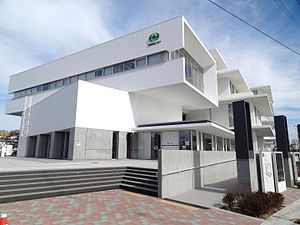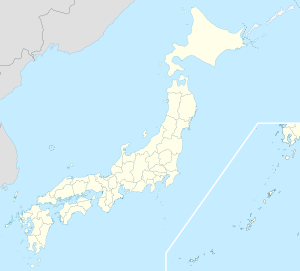Tamura (Fukushima)
| Tamura-shi 田村 市 |
||
|---|---|---|
| Geographical location in Japan | ||
|
|
||
| Region : | Tōhoku | |
| Prefecture : | Fukushima | |
| Coordinates : | 37 ° 26 ' N , 140 ° 34' E | |
| Basic data | ||
| Surface: | 458.30 km² | |
| Residents : | 35,532 (April 1, 2020) |
|
| Population density : | 78 inhabitants per km² | |
| Community key : | 07211-7 | |
| Symbols | ||
| Flag / coat of arms: | ||
| Tree : | Oak | |
| Flower : | azalea | |
| Bird : | Japanese Bush Warbler | |
| town hall | ||
| Address : |
Tamura City Hall 20 Aza Babakawahara, Funehiki, Funehiki-machi Tamura -shi Fukushima 963-4393 |
|
| Website URL: | http://www.city.tamura.lg.jp/ | |
| Location Tamuras in Fukushima Prefecture | ||
Tamura ( Japanese 田村 市 , - shi ) is a city in Fukushima Prefecture in Japan .
geography
Tamura is located in the western Abukuma highlands . The highest elevation, also of the Abukuma highlands, is the Ōtakine-yama ( 大 滝 根 山 ) with 1192.5 m on the border with Kawauchi .
history
Tamura was created on March 1, 2005 from the union of the small towns Funehiki ( 船 引 町 , - machi ), Ōgoe ( 大 越 町 , -machi ), Takine ( 滝 根 町 , -machi ) and Tokiwa ( 常 葉 町 , -machi ), as well as the Miyakoji Village ( 都 路 村 , - mura ) in Tamura County . The parish took its name from the district in which its predecessor parishes were, although other names were previously discussed such as Abukuma ( あ ぶ く ま 市 ), Abukumakōgen ( あ ぶ く ま 高原 市 , "Abukuma plateau"), Midori ( み ど り 市 , " green [e city] "), but also Tamura in Hiragana spelling. Tamura goes back to Sakanoue no Tamuramaro , a general from the 8th / 9th centuries. Century that subjugated the local Emishi .
Tōhoku earthquake and nuclear disaster 2011
and the long-term evacuation zones
Orange = restricted area within a 20 km radius
Yellow = "Evacuation Prepared Area"
Pink = "Deliberate Evacuation Area"
In addition to the restricted area and “Deliberate Evacuation Area”, there are 3 categories:
Area 1 : Area ready for the evacuation order to be lifted
Area 2 = residents are prohibited from permanent residence
Area 3 = long-term unsuitable for return of residents
Damage and sacrifice
In the Tōhoku earthquake on March 11, 2011, 19 residential buildings were completely destroyed and 196 partially destroyed.
The Fire and Disaster Management Agency (FDMA) reported a death for Tamura as a result of the Tōhoku disaster of 2011 up to its 148th damage report of September 9, 2013, then increased its information in its 149th damage report of September 7, 2013 March 2014 to nine deaths and by the 157th damage report from March 7, 2018 to 14 deaths.
evacuation
The community, which had a population of 40,422 in the 2010 census, was affected by the natural disaster- struck Fukushima nuclear disaster .
As a countermeasure to the nuclear disaster, a restricted area was designated around the Fukushima Daiichi nuclear power plant within a radius of 20 km. However, there were also many other locations with high radiation values beyond this 20 km radius, as radioactive particles were carried away from the damaged power plant by the wind. These places included Tamura and 10 other villages and cities, including Minamisōma , Naraha , Tomioka , Kawauchi , Ōkuma , Futaba , Namie , Katsurao , Iitate and Kawamata . According to the evacuation orders of May 7, 2013, these regions were divided into four different categories according to their radioactive exposure: Areas with a radiation exposure of less than 20 mSv per year, which were treated by the government as a threshold value for permanent return Category 1. Areas of this Category 1 could be entered at their own discretion and without the use of protective equipment with the only restriction that they were not allowed to stay overnight there. These areas were ready for the evacuation order to be lifted. In areas with a radiation exposure between 20 and 50 mSv per year (category 2), residents were prohibited from permanent residence. Areas with over 50 mSv per year (category 3) were seen as unsuitable for a return of residents in the long term. A fourth evacuation area had a special status.
The March 2011 evacuation order for Miyakoji District, Tamura City, was lifted on April 1, 2014, allowing approximately 357 reported residents to return to their homes. It was the first case in which an evacuation order had been lifted after the nuclear accident.
Attractions
In Tamura there is the Dōyama-Ōji shrine ( 堂 山 王子 神社 , Dōyama-Ōji-jinja ) where Sakanoue no Tamuramaro is said to have successfully prayed for a victory. The shrine is now recognized as a National Asset of Cultural Interest.
A natural attraction are the stalactite caves, such as the 600 m long Abukuma cave ( あ ぶ く ま 洞 , Abukuma-dō ) with its 80 million year old stalactites , stalagmites and rare boxwork formations, as well as the 900 m long Irimizu stalactite cave ( 入 水 鍾乳 洞 , Irimizu shōnyūdō ), which is a national natural monument.
traffic
- Street:
- Ban'etsu Highway : to Niigata and Iwaki
- National Road 4: to Tokyo and Aomori
- National roads 288, 349, 399
- Train:
- JR Banetsu East Line : to Kōriyama and Iwaki
sons and daughters of the town
- Kōichirō Gemba (* 1964), politician
Neighboring cities and communities
Web links
Individual evidence
- ↑ 協議 第 9 号 新市 (町) の 名称 に つ い て 、 次 の と お り 提出 す る. . (PDF) (No longer available online.) Tamura, June 2, 2003, p. 25 , formerly in the original ; Retrieved December 23, 2011 (Japanese). ( Page no longer available , search in web archives ) Info: The link was automatically marked as defective. Please check the link according to the instructions and then remove this notice.
- ↑ a b 13. 田村 市 と 田村 麻 呂 伝 説 (田村 市) . In: ふ く し ま の 歴 史 と 文化 の 回廊 . Fukushima Prefecture, archived from the original on February 18, 2013 ; Retrieved August 10, 2016 (Japanese).
- ^ Reiko Hasegawa: Disaster Evacuation from Japan's 2011 Tsunami Disaster and the Fukushima Nuclear Accident . In: Studies . No. 5 , 2013, ISSN 2258-7535 , p. 1-54 . (Institut du développement durable et des relations internationales, IDDRI).
- ↑ Masaru Arakida, Mikio Ishiwatari: Evacuation . In: Federica Ranghieri, Mikio Ishiwatari (Ed.): Learning from Megadisasters - Lessons from the Great East Japan Earthquake . World Bank Publications, Washington, DC 2014, ISBN 978-1-4648-0153-2 , Chapter 11, pp. 99-108 , doi : 10.1596 / 978-1-4648-0153-2 ( work accessible online on Google Books [accessed April 3, 2018]). , License: Creative Commons Attribution CC BY 3.0 IGO.
- ↑ Mikio Ishiwatari, Satoru Mimura, Hideki Ishii, Kenji Ohse, Akira Takagi: The Recovery Process in Fukushima . In: Federica Ranghieri, Mikio Ishiwatari (Ed.): Learning from Megadisasters - Lessons from the Great East Japan Earthquake . World Bank Publications, Washington, DC 2014, ISBN 978-1-4648-0153-2 , chap. 36 , p. 331–343 , doi : 10.1596 / 978-1-4648-0153-2 ( work accessible online on Google Books [accessed April 3, 2018]). , here: p. 335, Map 36.1 "Rearrangement of evacuation zoning" "Source: Ministry of Economy, Trade and Industry.", License: Creative Commons Attribution CC BY 3.0 IGO.
- ↑ Evacuation Areas Ministry of Economy, Trade and Industry (METI), (METI Measures and Requests in response to the Great East Japan Earthquake> Assistance of Residents Affected by the Nuclear Incidents> Evacuation Areas): Restricted areas and areas to which evacuation orders have been issued (June 15, 2012) ( Memento July 9, 2018 on WebCite ) (PDF)
- ↑ a b 平 成 23 年 (2011 年) 東北 地方 太平洋 沖 地震 (東 日本 大 震災) に つ い て (第 157 報) ( Memento of March 18, 2018 on WebCite ) ( PDF ( Memento of March 18, 2018 on WebCite )), 総 務省 消防 庁 (Fire and Disaster Management Agency), March 7, 2018.
- ↑ 平 成 23 年 (2011 年) 東北 地方 太平洋 沖 地震 (東 日本 大 震災) に つ い て (第 148 報) ( Memento from April 14, 2018 on WebCite ) ( PDF ( Memento from April 14, 2018 on WebCite )), 総 務 省 消防庁 (Fire and Disaster Management Agency), 148th report, September 9, 2013.
- ↑ 平 成 23 年 (2011 年) 東北 地方 太平洋 沖 地震 (東 日本 大 震災) に つ い て (第 149 報) ( Memento from April 14, 2018 on WebCite ) ( PDF ( Memento from April 14, 2018 on WebCite )), 総 務 省 消防庁 (Fire and Disaster Management Agency), 149th report, March 7, 2014.
- ↑ 平 成 22 年 国 勢 調査 - 人口 等 基本 集 計 結果 - (岩手 県 , 宮城 県 及 び 福島 県) ( Memento from March 24, 2018 on WebCite ) (PDF, Japanese), stat.go.jp (Statistics Japan - Statistics Bureau , Ministry of Internal Affairs and communication), 2010 Census, Summary of Results for Iwate, Miyagi and Fukushima Prefectures, URL: http://www.stat.go.jp/data/kokusei/2010/index.html .
- ↑ a b First Fukushima residents go home to Miyakoji - The first permanent returns were made today by Fukushima residents displaced by the nuclear accident three years ago ( Memento from April 14, 2018 on WebCite ) , world-nuclear-news.org, 1. April 2014.
- ↑ Dinil Pushpalal, Zhang Yan, Tran Thi Diem Thi, Yuri Scherbak, Michiko Kohama: Tears of Namie: An Appraisal of Human Security in the Township of Namie . In: Dinil Pushpalal, Jakob Rhyner, Vilma Hossini (eds.): The Great Eastern Japan Earthquake 11 March 2011: Lessons Learned And Research Questions - Conference Proceedings (11 March 2013, UN Campus, Bonn) . 2013, ISBN 978-3-944535-20-3 , ISSN 2075-0498 , pp. 80-87 .
- ↑ a b Shigenobu Nagataki: Outline of the Fukushima Accident and its Countermeasures at the Initial Period. Remediation: Achievements Made so far and Future Plans for Recovery . In: Radiation Protection Practice . tape 21 , no. 1/2015 , 2015, ISSN 0947-434X , p. 8-12 .
- ↑ あ ぶ く ま 洞 ト ッ プ ペ ー ジ . Tamura, accessed August 10, 2016 (Japanese).
- ↑ 入 水 鍾乳 洞 . Tamura, accessed August 10, 2016 (Japanese).






